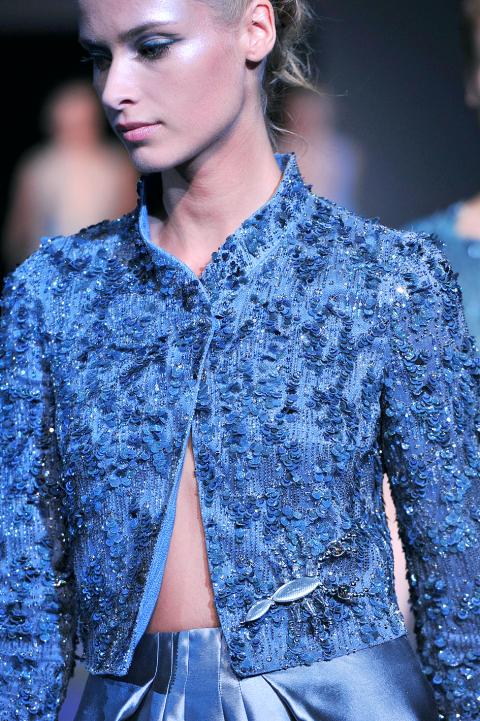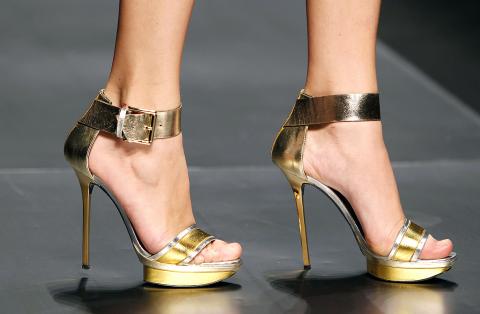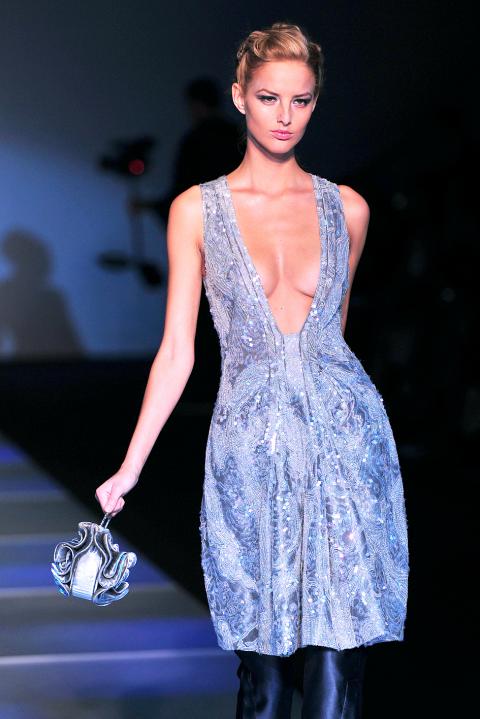Milan fashion designers are investing heavily in gold, no matter what the stock market is doing.
Gold lame, gold sequins, gold embroidery and gold baubles figured prominently in styles for next spring and summer that were presented in Milan over the past week, as if to impart the Midas touch at a moment of economic uncertainty.
Perhaps it is not coincidental that the era most frequently evoked during Milan fashion week was the roaring 20s, seen through its sequined and beaded drop-waisted flapper dresses. The carefree, fun decade ended with the devastating 1929 stock market crash.

Photo: AFP
The collective fashion response from Milan seemed to be: If we’re all going down, let’s at least look ladylike.
Styles on the Milan runways were decidedly mature, not girlish. There were proper leather handbags with handles or smart clutches.
The sandal has returned, replacing last year’s practical boot, in heels or platforms. Often gilded, the sandals proved challenging to some models who stumbled on the runway, as well as to fashionistas attending the shows, who quickly adapt to even the mere whiff of a trend. Makeup was mostly natural with flashes of glitter, and hair, often teased, was pulled back.

Photo: Reuters
Summer next year marks the return of the pleated skirt, often with demure, knee-length hemlines. Soft cuts were set off by lace, satin and chiffon fabrics — sometimes paired with heavier textures like leather and wool.
Designers didn’t forego sexy looks. While keeping the skirt lengths long, they allowed women to show off their legs with deep slits or sheer fabrics. Necklines plunged, shoulders were bared and backs dipped low.
The drop-waisted and no-waist dresses gave designers all the license they needed to play with beading, sequins and fringe. Embroidery was another favorite. In another nod to glamour, many trotted out cinched-at-the-waist swimsuits.

Photo: AFP
While shades for the summer are mostly muted, there were some flashes of color in bold tropical prints, animal patterns and floral designs. The burst of color was the surest sign that Milan fashion remains upbeat despite the gloom.
ARMANI
“A pearl of a lady” is how designer Giorgio Armani defined his 2012 summer woman. The ultra-feminine collection is created out of fabrics that have the iridescence of a precious pearl and the lightness of a feather.
Departing from the dress and skirt look proposed by most designers in Milan, Armani favors wafer-thin trousers delicately slit in the front. He pairs them with a jacket, cut on the bias and devoid of collar and buttons, or allows them to peep out from under a skirt or dress.
Water is another theme of the collection, with iridescent aquamarine and white silk for satin gowns with sequins, which sparkle on the outfits like a morning dew.
Dress hemlines range from knee to ankle, and are cut from ultra-light fabrics that caress rather than hug the body.
Mixing night and day, the designer paired his evening wear with flats, saving high heels for daytime dressing. For his finale, Armani sent out three models in identical see-through strapless evening gowns, chastely covered in a shower of raindrop sequins.
DONATELLA VERSACE
Donatella Versace showed her second line Versus collection in the courtyard of the Versace palazzo in downtown Milan late Sunday. The summer Versus girl, as viewed by Scottish designer Christopher Kane, hand-picked by Versace to revive the once-flourishing line aimed at the younger set, is athletic and sexy.
Walking down a runway designed to resemble a basketball court, the young models looked like cheerleaders in their short pastel colored frilly skirts and matching tops.
The most creative part came in the cardio-electrogram zigzag prints in contrasting black and pink for sheath dresses as well as athletic tops.
DSQUARED2
DSquared2 saluted the summer rock festival — even the muddy ones.
More than four decades after Woodstock, designing twins Dean and Dan Caten have imagined a concert tour from London to Glastonbury, with rain certainly on the radar, creating high-heel rain boots for the chic rock concertgoer. From there, just about anything goes in Monday’s easy-to-wear line.
DSquared2 included elements that have permeated this round of Milan previews, notably fringe, bare backs, one-shoulder dresses and long skirts, but in a much more casual and youthful way.
Colors were lively, yellow, orange and green. The twins fashioned shirts emblazoned with the stars-and-stripes that draped, added denim short shorts — sometimes with pom-pom fringe — studded belts and leather vests with fringe. Fur wraps — one a fox — added a touch of glam. Flannel shirts and scarves were tied around the waist, ready for evening layering when temperatures cool. What else for accessories but concert wristbands, backstage passes, headbands, brightly colored mirrored sunglasses, even paired with a yellow rain slicker emblazoned with the slogan “Niagara Falls?”

In the March 9 edition of the Taipei Times a piece by Ninon Godefroy ran with the headine “The quiet, gentle rhythm of Taiwan.” It started with the line “Taiwan is a small, humble place. There is no Eiffel Tower, no pyramids — no singular attraction that draws the world’s attention.” I laughed out loud at that. This was out of no disrespect for the author or the piece, which made some interesting analogies and good points about how both Din Tai Fung’s and Taiwan Semiconductor Manufacturing Co’s (TSMC, 台積電) meticulous attention to detail and quality are not quite up to

April 21 to April 27 Hsieh Er’s (謝娥) political fortunes were rising fast after she got out of jail and joined the Chinese Nationalist Party (KMT) in December 1945. Not only did she hold key positions in various committees, she was elected the only woman on the Taipei City Council and headed to Nanjing in 1946 as the sole Taiwanese female representative to the National Constituent Assembly. With the support of first lady Soong May-ling (宋美齡), she started the Taipei Women’s Association and Taiwan Provincial Women’s Association, where she

Chinese Nationalist Party (KMT) Chairman Eric Chu (朱立倫) hatched a bold plan to charge forward and seize the initiative when he held a protest in front of the Taipei City Prosecutors’ Office. Though risky, because illegal, its success would help tackle at least six problems facing both himself and the KMT. What he did not see coming was Taipei Mayor Chiang Wan-an (將萬安) tripping him up out of the gate. In spite of Chu being the most consequential and successful KMT chairman since the early 2010s — arguably saving the party from financial ruin and restoring its electoral viability —

It is one of the more remarkable facts of Taiwan history that it was never occupied or claimed by any of the numerous kingdoms of southern China — Han or otherwise — that lay just across the water from it. None of their brilliant ministers ever discovered that Taiwan was a “core interest” of the state whose annexation was “inevitable.” As Paul Kua notes in an excellent monograph laying out how the Portuguese gave Taiwan the name “Formosa,” the first Europeans to express an interest in occupying Taiwan were the Spanish. Tonio Andrade in his seminal work, How Taiwan Became Chinese,